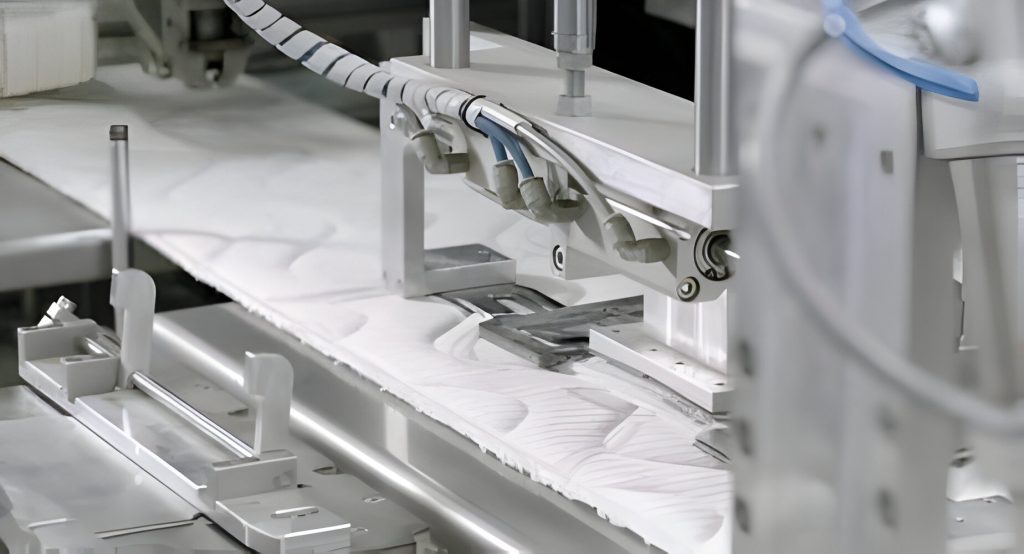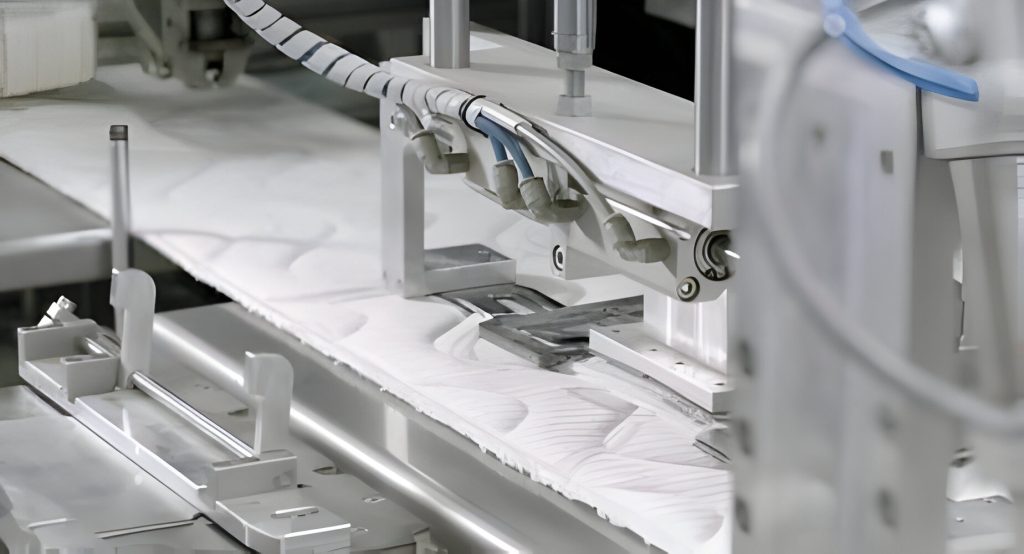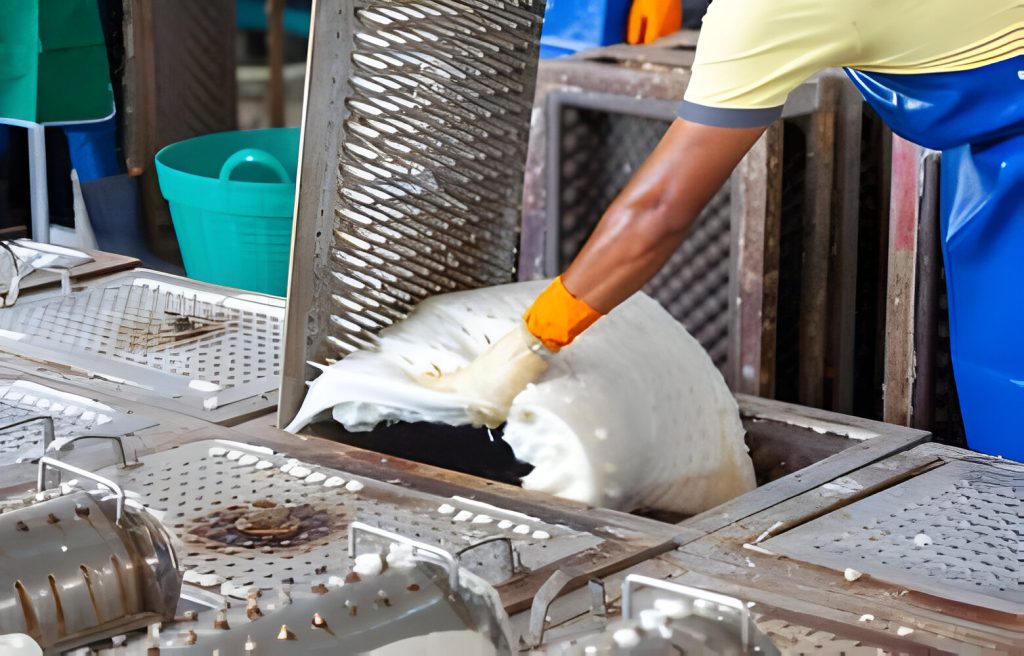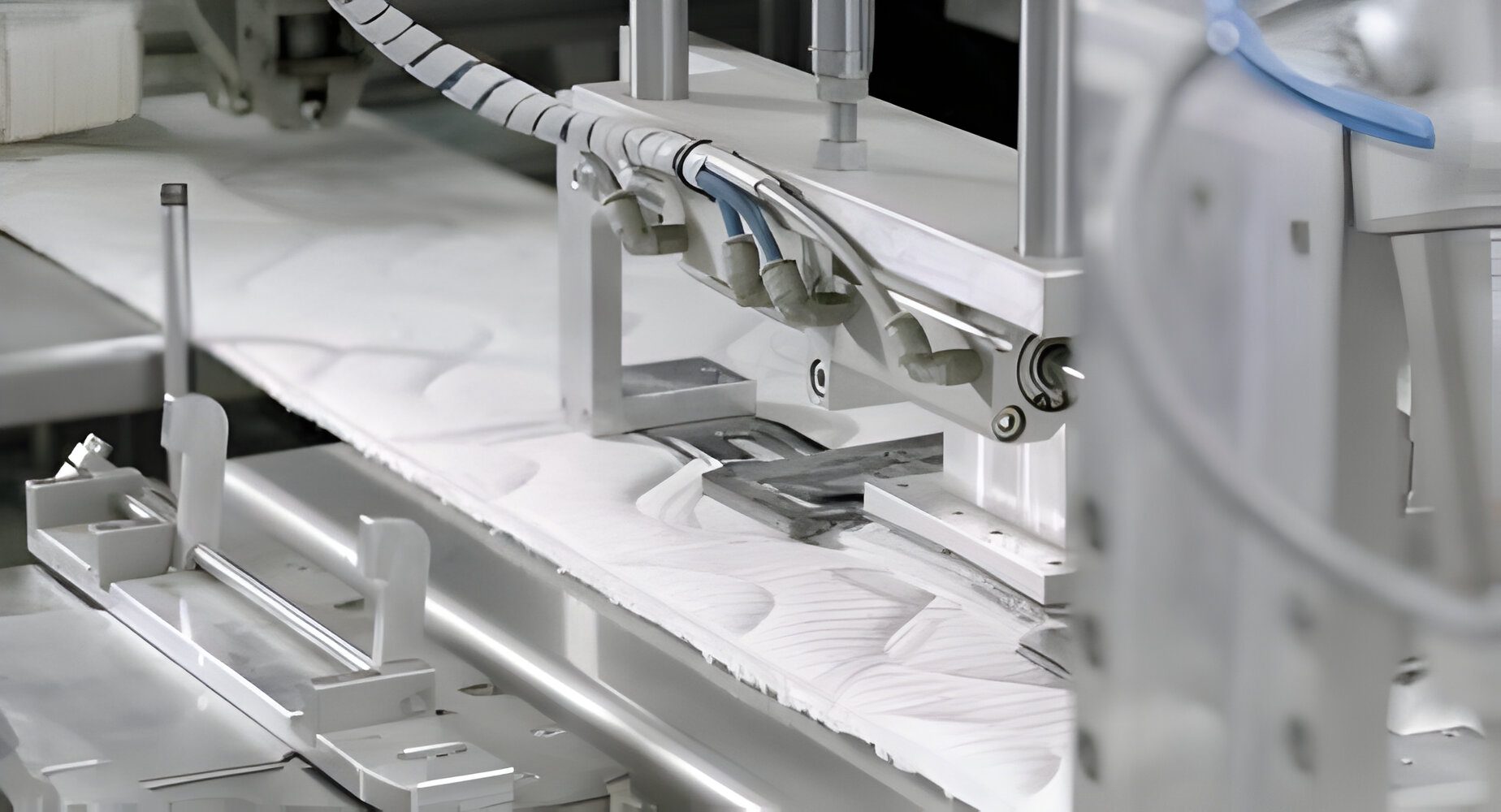A complete production line for pillows integrates tools and machinery to create pillows from raw materials to finished products. This line streamlines pillow manufacturing processes, enhancing efficiency and productivity.
Embark on a journey of efficiency in your textile enterprise with a state-of-the-art complete production line for pillows. Designed for optimal performance, this assembly line incorporates advanced machinery that encompasses filling, sewing, and packaging – all tailored to the unique needs of pillow production.
By embracing such a fully integrated system, businesses can significantly boost their output, cut labor costs, and ensure consistent product quality. The line’s intuitive design and automation minimize errors and reduce the need for manual intervention, making it an intelligent investment for manufacturers aiming to scale up their production and satisfy growing market demands. With this production line, companies are well-equipped to deliver top-notch pillows that provide the comfort and support consumers yearn for.
The Pillow Production Panorama

The world of pillow production is a fascinating blend of tradition and innovation. For comfort, support, or decor, pillows are essential to everyday life. Understanding the dynamics of a complete production line for pillows offers insights into the consumer market’s demands and the manufacturing world’s responses.
Types Of Pillows In The Market
Today’s market bursts with a variety of pillows, each serving different needs:
- Memory Foam – adapts to body shape
- Feather – offers natural softness
- Latex – provides firm support
- Microbead – for contoured comfort
- Cotton – breathable and hypoallergenic
- Water – customizable firmness
- Buckwheat – durable and eco-friendly
Focusing on these types allows manufacturers to target specific customer needs and preferences.
Evolution Of Pillow Manufacturing
Over the years, pillow manufacturing has transformed significantly:
- Handcrafted Era – artisans made pillows one by one
- Industrial Age – machines began mass production
- Technological Advancements – automation and intelligent machinery took over.
- Customization – on-demand manufacturing customized for individual comfort
- Eco-Consciousness – shift towards sustainable materials and processes
This evolution has allowed for greater efficiency, customization, and consideration for the planet.
Setting Up A Pillow Production Line
Embarking on establishing a Complete Production Line for Pillows is an exciting venture. This setup offers an opportunity to meet the growing demand for comfort in homes and hotels. Pay close attention to the necessary steps to ensure efficiency and quality.
Efficient Pillow Manufacturing System>
The Efficient Pillow Manufacturing System is a comprehensive solution designed to streamline the production process of pillows. By integrating advanced technology and optimized workflows, this system enhances productivity while maintaining high-quality standards.
Everything from fabric cutting and stuffing to stitching and packaging is carefully orchestrated to minimize waste and maximize efficiency. With automated machinery and intelligent controls, manufacturers can meet increasing demand with incredible speed and precision, ensuring timely delivery of pillows to the market.
This system revolutionizes pillow manufacturing by optimizing resources and enhancing overall operational efficiency.
Site Selection And Layout Considerations
Choosing the right location is crucial for your pillow production line. Consider factors like accessibility, space, and potential for expansion. The layout must promote a seamless flow of operations.
- Accessibility for suppliers and distributors
- Ample space for machinery and storage
- Options for future growth
- Compliance with safety regulations
Essential Machinery And Equipment
Acquiring the right tools guarantees a high-quality end product. Your pillow production line needs essential machines to start.
Machinery Function
Fabric cutting machine: cuts cloth to exact measurements
Sewing Machines stitch pillowcases together
Filling Machine Inserts stuffing into cases
Packaging Equipment Packs pillows for shipment
Sourcing Raw Materials
Quality pillows begin with high-grade materials. Ensure you have reliable suppliers for fabric, stuffing, and threads.
- Identify fabric types> cotton, polyester, memory foam
- Choose stuffing> feather, fiberfill, latex
- Stock up on resilient threading materials
Pillow Fabrication Processes
Behind every cozy pillow is a series of detailed fabrication processes. Crafting the perfect pillow involves precision and care. The complete production line for pillows ensures that every aspect, from softness to shape, meets high-quality standards. Join us as we explore the critical steps in the pillow-making journey, guaranteed to lead to your ultimate comfort. View the home page link.
Integrated Pillow Production Solution>
The Integrated Pillow Production Solution revolutionizes manufacturing by combining cutting-edge technology with efficient production methodologies.
This innovative system streamlines every stage of pillow manufacturing, from material selection to final packaging, ensuring high-quality products and optimized workflow. Integrating automated machinery, intelligent sensors, and advanced analytics enhances productivity while minimizing waste and errors.
With its ability to adapt to diverse production needs and deliver consistent results, the Integrated Pillow Production Solution sets a new standard for efficiency and excellence in the industry.
Cutting And Sewing
The first step in pillow manufacturing is cutting and sewing. High-quality fabric, chosen for durability and comfort, is cut into precise shapes. These pieces come together under skilled hands or machines, stitching them to form the pillowcase. Cutting and sewing are crucial for defining the pillow’s shape and longevity.
Filling And Sealing
Next, we have the filling and sealing process. This involves stuffing the cut and sewn cases with foam, feathers, or synthetic fibers. The amount of filling determines the pillow’s firmness and fluffiness. The opening is sealed once filled to the perfect level, giving a plush, comfortable finish.
Adding Special Features

Finally, special features may be added to enhance the pillow’s functionality. These can include-
- Memory foam inserts for extra support
- Cooling gel layers for temperature regulation
- Waterproof liners for easy cleaning
With these features, pillows provide comfort and adapt to your unique needs for a good night’s sleep.
Quality Assurance In Complete Production Line for Pillows
Quality Assurance in Pillow Production ensures every sleeper gets the perfect night’s rest. Top-notch materials, expert craftsmanship, and rigorous testing define premium pillow manufacturing. A complete production line for pillows adheres to stringent quality protocols. Let’s explore the components that attest to a pillow’s integrity and comfort.
Standards And Certifications
Quality begins with a solid foundation. Pillows must meet specific industry standards to ensure safety and excellence. Manufacturers follow guidelines such as the International Organization for Standardization (ISO) and the American Society for Testing and Materials (ASTM).
- ISO 9001: Focuses on quality management systems.
- ASTM D3574: Tests for foam and latex pillows.
- Certifications like CertiPUR-US for foam material safety.
- Oeko-Tex Standard 100 confirms no harmful substances.
Testing Techniques For Pillows
Pillows undergo multiple tests to ensure durability and support. These processes mimic real-life usage and stress to guarantee a pillow’s longevity.
Test Purpose
Compression Test Assesses firmness and returns to shape.
Tensile Strength Test Evaluates fabric and seam strength.
Flammability Test Checks for fire resistance.
Fill Power Test Measures loft and insulation for down pillows.
Packaging For Protection And Presentation
Secure packaging preserves a pillow’s quality from factory to bedroom. Manufacturers use robust and attractive packaging to protect against damage and dust.
- Vacuum-sealed bags ensure cleanliness and are tamper-proof.
- Sturdy boxes prevent deformation during shipping.
- Branded packing enhances appeal and brand recognition.
Navigating Challenges In Production

Challenges in Pillow Production Line
Pillow manufacturing is an intricate process. A full production line orchestrates various machines for filling, sealing, and finishing pillows. This streamlined system encounters hurdles that require expert navigation to maintain efficiency. Here, we explore the common challenges in a complete production line for pillows and discuss strategies to overcome them.
Managing Production Costs
Controlling expenses is vital to a profitable pillow production line. Costs surge from materials, labor, and machinery maintenance. To manage, consider the following steps:
- Bulk purchasing – reduces material costs.
- Automation – minimizes labor costs.
- Regular servicing – prevents costly breakdowns.
Ensuring Sustainability
Sustainability drives the future of manufacturing. With a focus on eco-friendly practices, a pillow production line should adopt:
- Recycled materials – for eco-conscious consumers.
- Energy-efficient machines – to lower carbon footprint.
- Waste reduction strategies – to enhance sustainability.
Adapting To Market Trends
Staying relevant is pivotal. Market demands shift, and a production line must reflect these trends:
- Research – keeps you ahead of changing preferences.
- Flexibility in design – allows swift response to trends.
- Product diversification – caters to a broader audience.
Marketing And Sales Strategies
Creating a complete production line for pillows involves more than just manufacturing. A strategic approach to marketing and sales is crucial. Companies must identify a suitable customer base, stand out in the market, and tap into effective sales channels.
Target Market Identification
Knowing your audience is the first step in a robust sales strategy. Understand their needs and preferences. Use data to make informed decisions. This data guides product development and marketing efforts to appeal to the right demographic.
- Survey potential users to uncover their pillow preferences.
- Analyze competitors to find market gaps.
- Assess economic factors that influence buying patterns.
Branding And Product Differentiation
Mark a unique space in the marketplace. Distinguish your pillows with innovative features or materials. Make a brand that appeals to your intended market. Focus on crucial differentiators like quality, design, and benefit.
Feature Benefit
Memory Foam Better neck support
Hypoallergenic Materials Safe for Allergy Sufferers
Cooling Gel Comfort in Warm Climates
Online And Offline Sales Channels
Utilize a mix of digital and physical storefronts to reach customers. Optimize your online presence. Engage with customers through social media and your website. Offline, consider partnering with retailers. Attend trade shows. These spaces present opportunities to connect with buyers directly.
- Develop an e-commerce website for direct online sales.
- Work together with internet retailers such as eBay or Amazon.com.
- Build relationships with physical retailers for in-store sales.
- Exhibit at trade shows for industry networking.
Frequently Asked Questions On Complete Production Line For Pillows
How Are Pillows Manufactured?
Pillows are typically manufactured through material cutting, sewing, stuffing with filling materials like foam or feathers, and finally closing the seams. This production follows a streamlined assembly line for efficiency and consistency.
What Was Used Before Pillows?
Before the invention of pillows, ancient civilizations used wooden or stone headrests to support the head during sleep. Natural materials like straw, reeds, or stuffed fabric evolved as softer alternatives.
What Are Pillows Filled With?
Pillows can be filled with various materials, including down feathers, memory foam, polyester fiber, cotton, buckwheat hulls, and latex. Each filling offers different comfort levels and support characteristics.
Who Invented Pillows?
Pillows date back to ancient Mesopotamia, around 7,000 BC. Early users crafted them from stone. The design evolved with softer materials like down feathers used by Egyptians.
Conclusion
Embarking on the pillow production journey demands precision, efficiency, and the right technology. This guide offers a roadmap for every entrepreneur ready to capitalize on the thriving bedding market. Embracing a complete production line enhances throughput and quality, setting the stage for business success.
It’s your turn to make the dream of a pillow empire a comfortable reality.

I am a travel specialized writer and blogger based in the USA and UK, CANADA. I have four years of experience in travel and all types of tours. So I work on solving these issues and give various tips on these issues. I handling carefully of these issues. So, I will share this information with everyone.

